Let me introduce you to the Cantrip Cartel™, the stars of today’s article:
Brainstorm — Ponder — Preordain
These three innocuous-looking spells have an impact and complexity level far above what one would suspect on first sight. Playing cantrips* correctly is actually very challenging and a format with good cantrips is surprisingly different from one without them. I believe cantrips are actually insanely good, for reasons that will soon be obvious, and today’s article will attempt to bring you round to my point of view as well as teach you how to make the most out of your cantrips.
*I’ll use cantrip to mean library manipulation cards like these throughout the article, not traditional cantrips that provide an effect but don’t cost you a card like Wall of Omens. Would you really want to read the words card-quality cantrip a million times today?
The Cantrip-Effect and Why You Should Run Preordain In Standard
I can’t fathom why there are people who don’t run Preordain in their Standard blue decks. Are they really being serious? Sure, Preordain ties up mana for what looks like a minor effect. In reality, though, the cumulative effect of casting cantrips throughout a tournament is far higher than we consciously realize, exactly because their visible impact is so minor. What efficient cantrips do is change the fabric of the game.
Imagine you could make the right play every time you needed to make a decision. Now, what would your losses come from the overwhelming majority of the time? Right, awkward draws. This is where cantrips shine. By allowing you to cheaply manipulate which cards will enter your hand, cantrips reduce the randomness throughout the game immensely and allow you to control your destiny.
The filtering capacity cards like Preordain provide also has other benefits, such as making one-ofs actually good (find ’em or ditch ’em, cantrips do both), running fewer of all your situational cards because you’ll draw them at an increased frequency and allowing you to run the best spells instead of having to fill slots with weaker cards because you want to draw the effect more often. Why would you ever pass on an opportunity like that?
U/G Survival Players Are Doing It Wrong
Ever since Survival-Vengevine broke at GP Columbus this summer, I’ve wanted to ask Caleb Durward and all those people that used similar lists the same question. You’re running blue in Legacy and omitting Brainstorm? Seriously?
Caleb’s argument was that Brainstorm would conflict with optimal use of his mana while not providing much in return. He suggested that the tempo loss incurred by having to cast Brainstorm was so bad that he preferred using aggressive mulliganing to find his Survivals.
To me, this doesn’t make any sense at all. I see Survival as a comparatively slow combo deck that only has to stick one two-mana spell, and it will win eventually. You know what is good in combo decks? Being able to find your combo pieces without mulliganing to oblivion. You know what provides you with an excellent way to draw Survival more often and make your backup plans more consistent? Cantrips!
Take a look at this:
Creatures (18)
Lands (20)
Spells (22)

I don’t really want to discuss this deck in detail (hopefully the reign of Vengevine ends in a few weeks), but what I’d really like to talk about is why I think that adding the cantrips elevates this deck to the next level.
In more traditional versions, the slots taken up by eight cantrips here are filled with creatures, the argument being that you’re likely to come out of the gate fast, so that having to cast cantrips would only delay you. To me, that is absurd. The fastest and easiest way to win with this deck is to resolve Survival of the Fittest and having cantrips makes finding that Survival far more likely than aggressive mulliganing alone, for obvious reasons. In addition, all the actual good draws the original version has, this one does, too. So sure, casting Brainstorm might mean you won’t play a creature (or Survival) on turn two once in a while. I’d still rather skip the turn two play and find a Survival for turn three than have to try to beat down with Aquamoeba.
That isn’t all, though. While not having the Aquamoebas makes it harder to find the discard-outlet necessary for the back-up plan, the fact that Brainstorm and Ponder can find whichever piece you’re missing more than makes up for that. You only have four Vengevines and four Rootwallas, so these are as much or more of a limiting factor than the actual discard outlet. Therefore this version is actually at least as good at getting a fast Vengevine out as Durwards or other non-cantrip lists. The bonus? If you don’t have a Vengevine in hand, that blue card in your hand is not a crappy ‘Moeba but one of the absolutely best spells legal in the format, one that will help you find something actually impressive to do. In testing, this performed far above any non-cantrip Survival list I’ve tested. To make it work, though, you’ll need to know how to use the cantrips correctly.
To Cantrip or Not to Cantrip, That Is the Question
Last week I told you to not play Preordain in one of the examples, a point of view that I was sure would be controversial. I got the disagreements, but
I’m still convinced conserving Preordain is correct. I’ve been playing with cantrips for about a decade now, and in my experience holding them back
if you can
leads to a lot more value in the long run than playing them ASAP.
Holding back means that, once the opponent has decided on a certain course of attack, you can adapt to it more easily. Whichever resource your opponent is attacking (counterspells in hand, lands, life-total, etc), a cantrip can usually deliver more of that same resource. Yet for this to work, you already need to know what field of battle the opponent has chosen, which means not only should you know his deck but also what his draw looks like. The extra information you get is usually worth the wait.
That means I only exceptionally play my cantrips early, right? Far from it. Actually, I cast turn one and two cantrips a lot. The point is, I do so for a reason. Neither Ponder nor Preordain retroactively fix your draws like Brainstorm, so an informed early cantrip is of similar value to one played later in the game
as long as you are looking for something
. If your hand is already good enough, every turn you wait to play your cantrip makes it so that you might draw into what you want naturally, meaning the cantrip is suddenly free to go find something else.
Sadly, this opportunity doesn’t arise all that often because most hands aren’t ideal and hence we run the early cantrip. If we don’t need to, though, keeping it around is definitely the play.
So how do you know that it’s time to pay a blue and draw a card? Whenever you could play a cantrip, ask yourself this question:
What do I need?
If you can’t name a particular card or class of cards (like, say, removal) that you want to have access to now, hold back. This illustrates why game one turn one Preordain is such a waste outside of combo-decks (those always need specific cards, otherwise they should already have ended the game). You simply don’t have the necessary information to know what you need at that point!
The choices that occur while you resolve your cantrips should be comparatively straight-forward, the timing is what makes or breaks you. If you’ve waited for the right moment to play your manipulation, you should know what you need, and not have trouble figuring out if the cards you’re looking at are going to be good enough to get the job done. If they’re not, you know how to get rid of them!
Chain Reaction
There is another important factor you have to take into account when you decide to play your cantrips: the number of cantrips you run and how many are in your hand. Generally speaking, the more cantrips you run or have, the earlier you should cast them.
If your hand has multiple cantrips, it’s likely light on other business, meaning that while you don’t know exactly what you need, any kind of business is acceptable for the moment. You’re also likely to be able to hold back some cantrips even if you blow one or two early, giving you sculpted draws early on as well as maximum value cantrips later.
In decks that run enough cantrips to find a new one roughly every four cards, it is actually in your interest to cast them a little earlier than you otherwise would in an effort to produce a cantrip-chain. If you manage to get to a point were you can cast a cantrip (nearly) every turn, your card quality is going to be far superior to your opponent’s, to the point where you can just trump him card for card. It is due to this possibility that I gave a collective name to the three members of the Cantrip Cartel (they work together, are very powerful and break the rules – yeah I know, I’m far too hung up on finding clever names for things).
Those of you that pay attention to Vintage might know that Brainstorm and Ponder were restricted in June 2008. Though this had to do with the fall-out of the Merchant Scroll – Gush era, the DCI’s reasoning behind the restriction was actually sound (not that that made it easier to accept, Brainstorm is just such a sweet card): Any Vintage-deck that wasn’t held back by specific game-plans (Workshop and Dredge, pretty much) had started to run the full eight Ponder and Brainstorm. Combined with the inordinate number of honest to god broken threats in Vintage, the filtering provided by chaining the cantrip eight-pack into other carddraw only to continue the cantrip-chain afterwards made decks extremely consistent in spite of the format’s one-of nature (restricted list).
I believe that with the printing of a ninth to twelfth cantrip, Legacy is moving closer to the same position Vintage was in back then than it has ever
been before. For the moment the only deck that really takes advantage of this is Ari Lax
CantripANT
. I’ve tested with the deck a fair share, and it almost never fizzles because the cantrips miss – assuming perfect play, that is. I’ve lost a number of games by screwing up my cantrip-sequencing, though, which led to me hitting the missing piece a turn too late.
As powerful as that deck is, I’m convinced that there has to be one out there that can make this engine completely absurd, I just haven’t found it yet. Until that happens, I’ll continue to try cramming the Cantrip Cartel into just about anything I can think of to see if I can get it to work. I haven’t anything to show for it yet, but I’ll let you know when I strike gold (probably after I’ve won a few tournaments first 😉 ).
Truly Difficult: Proper Sequencing
Playing one cantrip correctly isn’t that hard, even if we might disagree on the play anyway. Once you have several cantrips, though, things become truly convoluted. Again the real complexity is one of timing, in regards to both when to play your cantrips and in which order to cast them. I like to refer to this as sequencing.
Sadly there are few hard and fast rules for sequencing and the subject rapidly spirals out of control if you try to pin it down. Too much depends on what’s already in your hand, what you need, which exact cantrips you have and what deck you are playing, among other things. There are a few guidelines you can follow, though.
First up, while there is no generally correct way to sequence your cantrips, my default is to go with Preordain first if I’m likely to play another cantrip or shuffle this turn and to play Ponder if I don’t think I’ll mess with my library before my next draw step. My reasoning for this is that Ponder allows me to at least draw the second best card of the top three during my next draw-step instead of a random one as is likely if I Preordain.
The one clear-cut rule I can hand you is applicable if you’re looking for one specific card (or function, like a tutor to win with in the ANT-deck). In that case you only need to try to see the most cards possible. Assuming you have ample mana, you always want to play a Brainstorm last, because the cards it leaves on top limit how deep the other cantrips can dig (note that you might have to “waste” a different cantrip to clear the top if you have multiple Brainstorm). If you don’t have a Brainstorm, you’ll want to run all but one Ponder first (seeing up to four cards each – the three you see and the one you draw after you shuffle), follow this with all your Preordains (so that you actually keep the bad cards you scryed away on the bottom instead of shuffling them back in) and finish on your last Ponder (you get to see three cards deep into a library with some useless cards already put on the bottom).
On the other hand, if you plan to chain cantrips and are only looking for high-quality cards, you probably want to run Ponder first. If you shuffle, you have lost nothing compared to the blind Preordain. If you find one or two cards you want, though, following that Ponder with Preordain allows you to take the best card(s) and refresh the top of your library afterwards, similar to what a Fetchland does (again, already having a shuffle-effect changes this because you can go Preordain into Ponder to see a full five to seven cards before shuffling anything useless away).
As you can see by how many considerations even these comparatively simple scenarios demand, the correct sequencing of cantrips rapidly becomes something that is hard to address meaningfully in the abstract. I haven’t even touched on the way you should be spacing out your cantrips over multiple turns in some situations while in others you’ll want to just get as deep into your library as possible this turn and be free to do other things later. In addition, each different combination of cantrips in your hand wants to be played in a particular order to maximize it, further influenced by the availability of extraneous shuffle-effects and the deck you play.
Cantrip’s End
There is much more to be said about the correct use of cantrips, and to be comprehensive, nearly every deck would need its own article, because each deck uses its cantrips slightly differently. I hope this still served as a solid foundation for your own investigations into the Cantrip Cartel and made it clear why you should consider doing so.
Cantrips do something subtle to any format they’re legal in. They give those decks that play them an edge by severely reducing randomness. The more cantrips your deck plays, the less often you’ll simply miss on lands or draw all removal against control. Your losses will usually be your own fault because you screwed up a cantrip somewhere. So if you hate losing to mana screw as much as I do, get in touch with the Cantrip Cartel. They’ll help you out!
So will I for that matter. If there’s anything you want to ask, comment or criticize, take it to the forums. See you there or next week!
Carsten Kötter
Puzzling Bonus: Sequencer Training
As the learn-through-puzzling feature was so well-received last time, I’ll include a couple of situations here for you to sharpen your cantripping-skills with. I’m not sure if this works as well as teaching control through game-situations, because to be honest I’ve never tried to explain correct cantripping this way before. Ready to play guinea pig?
I’ll do a few things differently from last time, though. For one, you will only use a single deck,
CantripANT
. This exercise is about the correct sequencing of your cantrips, after all, so it makes sense to use the deck that runs the full Cartel. Secondly, instead of going through a complete analysis of each example directly afterwards, I’d like to hear your answers in the forums first, at which point I’ll give my point of view. I’m curious how many different possible solutions I’m going to see!
This is your question each time: On which turn and in what order do you plan to play your cantrips, assuming you draw nothing of relevance? (I know that’s not how it would work in a real game, but if we include changes caused by drawn cards this becomes completely unmanageable)? What do you hope to find with the cantrips?
Situation 1:
Your opponent opened with the classic start of Taiga, Kird Ape. It is now your first turn main phase:
Opponent:
Life: 20
Cards in hand: 5
In play:
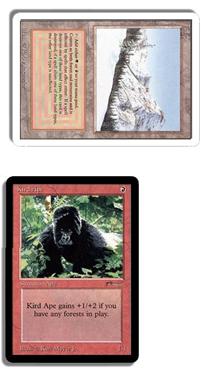
You:
In play: Nothing
In hand:
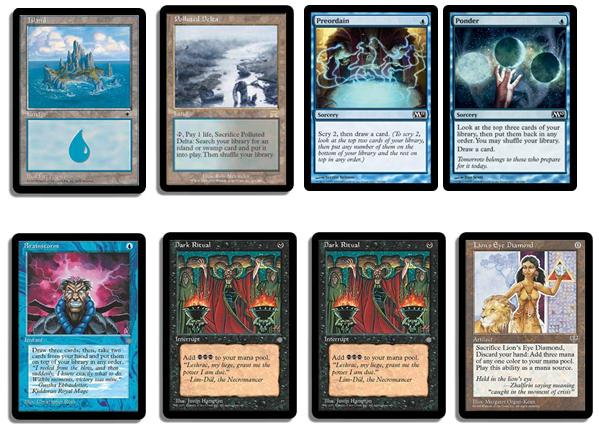
Life: 20
Situation 2:
Your position is exactly the same as in Situation 1, but this time your opponent has opened on Island, Aether Vial, so he’s probably playing
Fish
. Does that change your plans in any way?
Opponent:
Life: 20
Cards in hand: 5
In play:
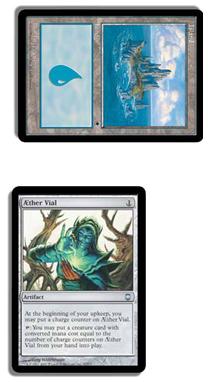
You:
In play: Nothing
In hand:
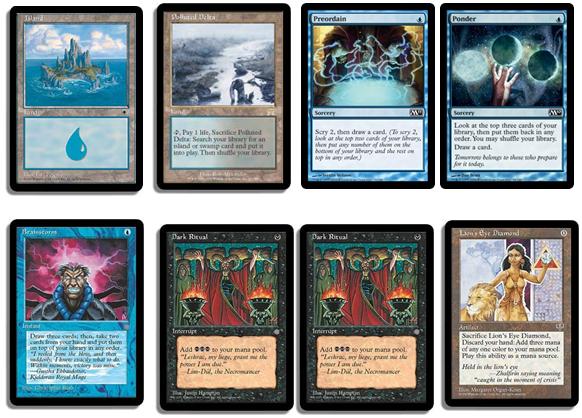
Life: 20
Situation 3:
You’re playing against a Zoo-player who had a very aggressive start, nearly racing you! Can you turn it around?
Opponent:
Life: 20
Cards in hand: 0
In graveyard: 2 Lightning Bolt, 1 Chain Lightning
In play:
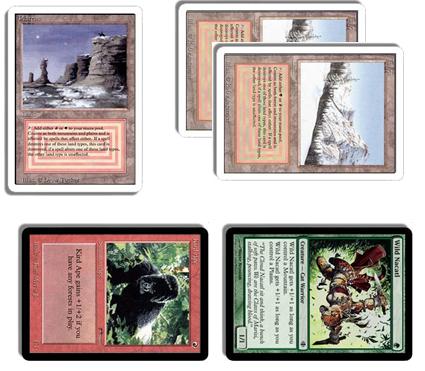
You:
In play:
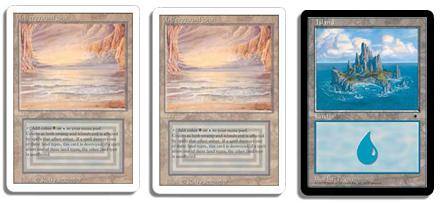
In hand:
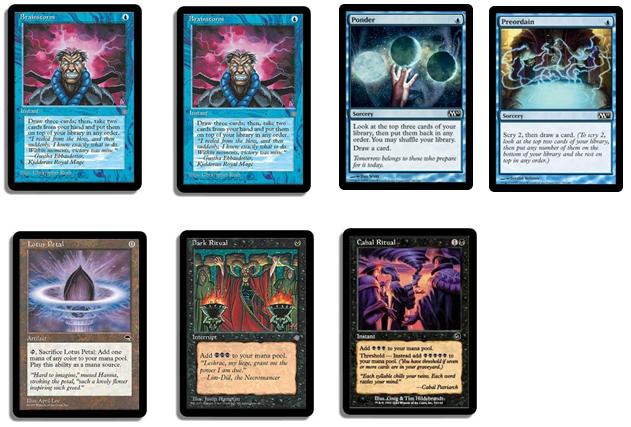
in Graveyard: 2 Preordain, 2 Ponder, 1 Polluted Delta
Life: 2
